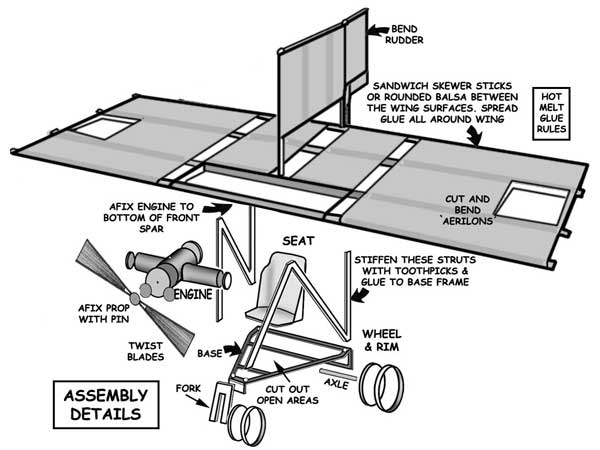


New Zealand's Bamboo Richard Pearse Monoplane
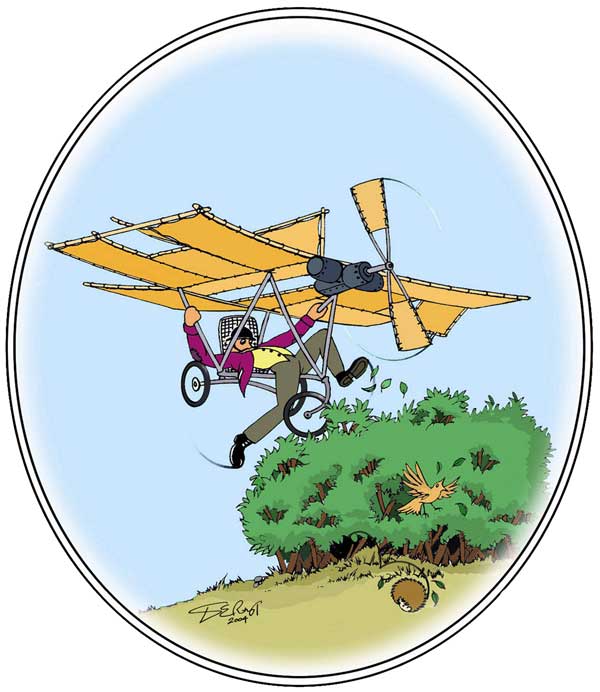
This original artwork by Derek Roberts is available in much higher quality (suitable for framing), on the Full Collection DVD.

Did Richard Pearse, the brilliant inventor, beat the Wrights into the air? By the looks of it he may have been trying to build a Mars Rover as well. Strange resemblance there.
"On or about 31 March 1903 Richard William Pearse of Waitohi New Zealand, became airborne in a high-wing monoplane he designed and built himself. This aircraft, of prophetic design, was powered by an ingenious gasoline engine which he also designed and constructed.
It was not until 17 December 1903 that the Wright Brothers' took to the air at the Kill Devil Hills in North Carolina.
Though Pearse later conceded that the Americans deserved the honor of being the first to make a controlled and sustained flight, there seems to be a very good chance that Bamboo Dick Pearce got into the air under power before they did.
..and another reason was that Pearse's machine did not demonstrate "controllable flight", by any use of the word... ;-)
Cool machine, though! ...Tim K
This delightful little Richard Pearce Monoplane model came about as a result of an email exchange with Dr Bill Tramposch,
CEO of New Zealand Historic Places Trust, And I'm so darn proud to share with you the fact that he's my brother..chip
What a beauty! This series is seriously grand! Now, if someone will please point me towards the door with the extra time... Wayne
Come on guys....... The Pearse story has been very solidly debunkedrepeatedly; most recently in an article in WWI Aero last year.If your really interested in aviation history, let me know and I'll look up the reference for you and if you don't have access to WWI Aero I'll copy the article and smail it to you. Please advise your pleasure.Cheers, Jim S
Richard Pearse's Early Flying Machine

Pearse is recognized as the first man in New
Zealand to lift off from the ground flying his home built powered
aircraft.
For the best part of a century, the activities of Richard William Pearse (1877-1953) were largely unknown outside the small, close-knit, farming settlement of Waitohi, in the South Island of New Zealand, where he was born and where he flew his aircraft in the very early part of the 20th century.
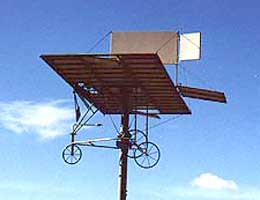 |
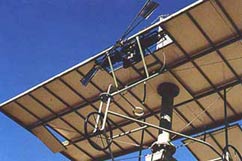 |
Whether or not Pearse flew in any acceptable sense, and regardless
of the exact date, his first aircraft was a remarkable invention
embodying several far-sighted concepts: a monoplane configuration,
wing flaps and rear elevator, tricycle undercarriage with steerable
nose wheel, and a propeller with variable-pitch blades driven by
a unique double-acting horizontally opposed petrol engine.

Yet this farmer's son, growing up and living far removed from the rest of the
world, dedicated his lifetime's energies to inventing things mechanical including
the designing and building of a suitable combustion engine and three aircraft,
in the first of which he would make a number of short pioneering flights.
Yet he was compelled to work mostly in secret in order to avoid those who opposed him on religious grounds, and others who claimed that he was a lunatic in his attempts to build a flying machine. His achievements were even more remarkable in that, unlike the Wright Brothers who employed skilled engineers and who later enjoyed the luxury of American Government sponsorship, Pearse designed, financed, and built everything himself. And he did not even have access to a university or library, but gained his knowledge solely through reading the magazines that he subscribed to.
Corroborated eyewitness accounts from school children at the time and in their 70/80s when interviewed, together with other somewhat conclusive evidence from the local school records, confirm that at least one of his powered flights took place on 31st March 1903. And there were numerous other trials taking place both before and after that. His most active flying year was obviously 1903.
Usually Pearse taxied and 'flew' his aircraft using his own or a neighbor's paddock. However if the paddocks were wet this made such use impossible, and Pearse would use the road running past the school and his farm. Other evidence points to him flying in the winter of 1903 - specifically on the 10th of July, 1903, just a few months before the Wrights' first flight. (Note: the seasons are reversed in the Southern Hemisphere).
Apparently the plane 'landed' on top of one of the many 12ft.
high, mainly uncut, box-thorn or gorse hedges surrounding the
paddocks in the neighborhood. He then left it there because of
a heavy fall of snow. Meteorological records for that time show
that snow fell on the 11th of July 1903, but that there was no
snow during any of the years immediately before or after that
date.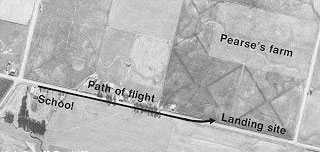
In his later trials he used a small hillock to take off from and flew over a 30ft. high river terrace to 'land' on the mostly dried up river bed below - From eye-witness reports, the lengths of his flights have been estimated to have varied between 50ft. and a quarter of a mile.
However it was some fifty years later that investigators were alerted to Pearse's flying activities by the discovery of a roughly constructed 'utility' aeroplane, his third, which never flew but which contained remarkably innovative features, which was found hidden in his work shed after he had died.
Subsequent searches of the area then discovered some remains of his earlier aircraft which had been thrown onto a rubbish dump in the mostly dried up river bed where he had last landed almost fifty years before.
These included engine cylinders, a cast iron piston, and a propeller.
Then in the mid-1970s, a replica of his 1902/3 aircraft with its
unique engine was constructed and exhibited at MOTAT, and then
went on tour throughout New Zealand - see photo at top of page. 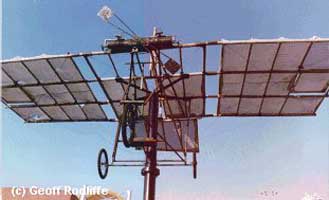 It
was also exhibited at the Vancouver Expo. '86 To get it to Canada,
it was dismantled and carried in the cargo hold of a Boeing 747!!
It
was also exhibited at the Vancouver Expo. '86 To get it to Canada,
it was dismantled and carried in the cargo hold of a Boeing 747!!
In 1974 the NZBC was involved in the making of a documentary film entitled "Richard Pearse." Whilst this turned out to be rather less than the hoped for historic record, it did serve to bring Pearse's achievements to the attention of the N.Z. populace at large.
For one scene a shaft-horse was supposed totow Pearse's first aircraft into a position for a simulated take-off using the replica. Unfortunately however the animal stamped heavily on the foot of the actor leading it and then galloped off across the paddock, fortunately straight into a 10 mph wind. Whilst everyone watched in horror the replica took off quite normally and rose as far as the towrope would allow.
It then stalled and nose-dived into the ground. The stability was remarkable and it lifted off with no tendency to roll. Luckily its bamboo frame was resilient and little actual damage was done. During this episode, which was watched by a number of spectators including four professional cameramen and five or six amateurs holding movie cameras, no-one had the presence of mind to pull the trigger; thus the most spectacular event of that day went unrecorded!!
In 1980 the replica was subjected to wind-tunnel tests at Auckland University, which confirmed that indeed it was possible for such a machine to have been capable of flying much like a micro light of today.
 Pearse was ahead of his time, the first and the only aviator who had at that time designed
his own unique internal combustion engine; and designed his own aircraft (pre-dating
the micro light by about seventy years).
Pearse was ahead of his time, the first and the only aviator who had at that time designed
his own unique internal combustion engine; and designed his own aircraft (pre-dating
the micro light by about seventy years).
He built both the engine and aircraft in his secluded elementary workshop with minimal assistance, enabling him to make a number of flights piloting the aircraft himself.
Pearse has been recorded as having stated he never flew with his first aircraft. Although he had been established in his own secluded workshop building engines and aircraft for five years previous to the year 1903, it has not been possible to establish how many aircraft he had built and experimented with before he was seen flying in 1903.
Pearse in a letter to the press mentions the year 1904 when he began studies to achieve aerial navigation, and that true aerial navigation was not achieved until 1905. There are accounts of a smaller machine preceding the better known flights of 1903 followed by a larger circular aircraft, another one of which little is known about, but which was built after he had moved to a very quiet secluded spot at a place called Milton.
Many years later the larger helicopter style, the original example of this circular aircraft, is now on display at the Auckland Museum MOTAT.
The various engines were equally numerous: relics of the 1900 two cylinder engine exist, a later more advanced four cylinder engine, an undiscovered multi-cylinder engine supposedly used at Milton, an engine for agricultural purposes, and a motor cycle engine which he used on the roads. And finally the very complex powerful engine fitted to the helicopter machine.
PIONEERING FEATURES

There were a number of pioneering features of the first known aircraft which are in use in modern aircraft even today. Pearse's advanced design used a tricycle landing gear, which would only come into general use thirty years later. And his aircraft really resembles the micro lights which would only be introduced almost seventy years later.
In particular, other early aviation pioneers such as the Wrights used primitive wing warping, or 'side tipping' as Pearse described it, to attempt to control an aircraft in flight. However Pearse introduced a flap system in place of the usual aileron which would avoid twisting the wing. This closely resembles the method of control now generally used in high speed aircraft.
And unlike the Wrights, Pearse wisely decided to eliminate the need for an engine with a flywheel. He did this by having a propeller firmly bolted onto the crankshaft, thus saving considerable weight. Arriving at the correct design for the propeller was in itself a monumental task. However the choice of direct drive was obviously justified: from 1906 onwards this method came into general use.
Richard Pearse (1877-1953), inventor and aviator
 Richard Pearse's first patented invention, dating from 1902,
was an ingenious new style of bicycle, bamboo-framed with a vertical-drive
pedal action, rod-and-rack gearing system, back-pedal rim-brakes
and integral tyre pumps.
Richard Pearse's first patented invention, dating from 1902,
was an ingenious new style of bicycle, bamboo-framed with a vertical-drive
pedal action, rod-and-rack gearing system, back-pedal rim-brakes
and integral tyre pumps.
But flying, not cycling, was his dream. Through Scientific American Pearse kept in touch with experimentation overseas. There is evidence he was working on ideas for powered flight from 1899 and had built his first two-cylinder petrol engine by 1902. He then constructed, using bamboo, tubular steel, wire and canvas, a low aspect ratio monoplane.
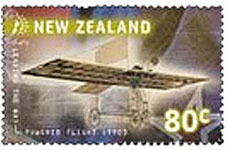 Of prophetic design, it closely resembled a modern micro light aircraft in appearance.
After considerable taxiing on his farm paddocks Pearse made his first public
flight attempt down Main Waitohi Road adjacent to his farm. After a short distance
aloft, perhaps 50 yards, he crashed on top of his own gorse fence. No details
were recorded, by Pearse or onlookers, of this tentative flight. In two letters,
published in 1915 and 1928, the inventor writes of February or March 1904 as
the time when he set out to solve the problem of aerial navigation. He also
states that he did not achieve proper flight and did not beat the American brothers
Orville and Wilbur Wright who flew on 17 December 1903.
Of prophetic design, it closely resembled a modern micro light aircraft in appearance.
After considerable taxiing on his farm paddocks Pearse made his first public
flight attempt down Main Waitohi Road adjacent to his farm. After a short distance
aloft, perhaps 50 yards, he crashed on top of his own gorse fence. No details
were recorded, by Pearse or onlookers, of this tentative flight. In two letters,
published in 1915 and 1928, the inventor writes of February or March 1904 as
the time when he set out to solve the problem of aerial navigation. He also
states that he did not achieve proper flight and did not beat the American brothers
Orville and Wilbur Wright who flew on 17 December 1903.
However, a great deal of eyewitness testimony, able to be dated circumstantially, suggests that 31 March 1903 was the likely date of this first flight attempt. (The year 1902 also has its advocates.) Pearse continued his flying experiments, achieving several further powered take-offs or long hops, most of them witnessed. None of them, in terms of length or control, was a true flight by any strict definition. In July 1906 he patented his aircraft.

 Ken Buckly shows off his Pearse electric powered monoplane |
 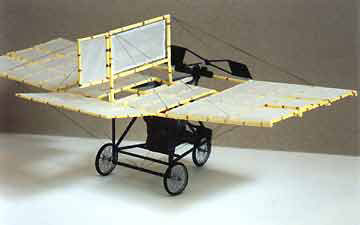 |



